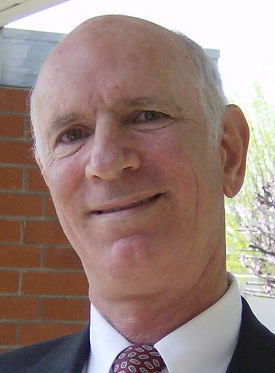“The Origins of Silicon Valley: Why and How It Happened”
“The Origins of Silicon Valley: Why and How It Happened”

Silicon Valley is commonly acknowledged as the tech capital of the world. When most people think of the Valley, they probably recall semiconductors, personal computers, software, biotech and self-driving cars. How did Silicon Valley come into being, and what can we learn? The story goes back to local Hams (amateur radio operators) trying to break RCA's tube patents, Stanford "angel" investors, the sinking of the Titanic, WW II and radar, and the SF Bay Area infrastructure that developed -- these factors pretty much determined that the semiconductor and IC industries would be located in the Santa Clara Valley, and that the Valley would remain the world’s innovation center as new technologies emerged and a model for innovation worldwide.
This talk will give an exciting and colorful history of device technology development and innovation that began in Palo Alto in 1909. You'll meet some of the colorful characters -- Cyril Elwell, Lee De Forest, Bill Eitel, Charles Litton, Fred Terman, David Packard, Bill Hewlett, Bill Shockley and others -- who came to define our worldwide electronics industries through their inventions and process development. You'll understand some of the novel management approaches that have become the hallmarks of its tech startups. Many of these attributes can be found, to greater or lesser extent, in other technology hubs; however, the SF Bay Area has five generations of experience, as well as a "critical mass" of talent, making it difficult for others to catch up. The key attributes will be illustrated and analyzed, for consideration by other tech hubs. [Key 10-minute extension] Then Mr. Wesling will briefly discuss the key technologies that he expects to be the most important during the 2020’s, including autonomous vehicles, virtual and augmented reality, artificial intelligence, and industrial IoT and analytics.
Date and Time
Location
Hosts
Registration
-
 Add Event to Calendar
Add Event to Calendar
Loading virtual attendance info...
- Webex
- Rochester, Michigan
- United States 48329
- Building: Virtual
- Room Number: Digital
- Contact Event Host
- Co-sponsored by Subra Ganesan
Speakers
 Paul Wesling of IEEE Life Fellow, BS-EE, MS-MatSci (Stanford U); retired from H-P/Tandem
Paul Wesling of IEEE Life Fellow, BS-EE, MS-MatSci (Stanford U); retired from H-P/Tandem
“The Origins of Silicon Valley: Why and How It Happened”
Silicon Valley is commonly acknowledged as the tech capital of the world. When most people think of the Valley, they probably recall semiconductors, personal computers, software, biotech and self-driving cars. How did Silicon Valley come into being, and what can we learn? The story goes back to local Hams (amateur radio operators) trying to break RCA's tube patents, Stanford "angel" investors, the sinking of the Titanic, WW II and radar, and the SF Bay Area infrastructure that developed -- these factors pretty much determined that the semiconductor and IC industries would be located in the Santa Clara Valley, and that the Valley would remain the world’s innovation center as new technologies emerged and a model for innovation worldwide.
This talk will give an exciting and colorful history of device technology development and innovation that began in Palo Alto in 1909. You'll meet some of the colorful characters -- Cyril Elwell, Lee De Forest, Bill Eitel, Charles Litton, Fred Terman, David Packard, Bill Hewlett, Bill Shockley and others -- who came to define our worldwide electronics industries through their inventions and process development. You'll understand some of the novel management approaches that have become the hallmarks of its tech startups. Many of these attributes can be found, to greater or lesser extent, in other technology hubs; however, the SF Bay Area has five generations of experience, as well as a "critical mass" of talent, making it difficult for others to catch up. The key attributes will be illustrated and analyzed, for consideration by other tech hubs. [Key 10-minute extension] Then Mr. Wesling will briefly discuss the key technologies that he expects to be the most important during the 2020’s, including autonomous vehicles, virtual and augmented reality, artificial intelligence, and industrial IoT and analytics.
Biography:
Paul Wesling has observed the Valley for decades as an engineer, executive, resident, and educator. He received degrees in electrical engineering and materials science from Stanford University, then worked locally at companies including Lenkurt Electric, Sperry-Univac, and Amdahl, joining Tandem Computers in Cupertino in 1985. His assignments included advanced technology reliability, mainframe testing, design of multi-chip module prototypes, and managing an NSF grant for the development of multimedia educational modules. Paul retired from HP in 2001, then served as “Mr. IEEE” for the San Francisco Bay Area for 10 years. He is a Life Fellow of the IEEE. As vice president of publications for the IEEE Electronics Packaging Society for 22 years, he supervised four archival journals and a newsletter. He received the IEEE’s Centennial Medal, the Board's Distinguished Service award, the Society Contribution Award, and the IEEE's Third Millennium Medal. He edits the IEEE/ASME/SEMI Heterogeneous Integration Roadmap for prediction of technology directions in electronics packaging
Agenda
6:00 pm Networking, Introductions, etc.
6:10 pm Start of Lecture on SV
7:10 pm Extension Lecture: Tech Projections by Paul W
7:20 pm Q&A
Media
| silicon valley flyer | silicon valley flyer | 1.09 MiB |

